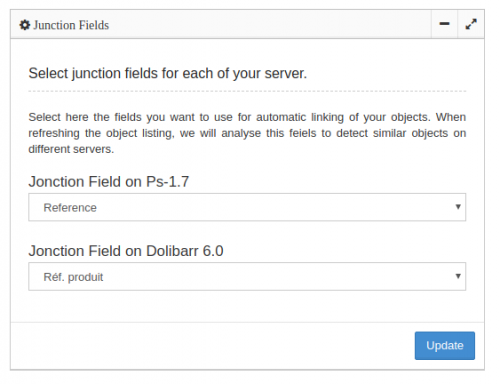Configure Junction Fields
Junction Fields
A junction field is a unique data for each object. By choosing this field from the available fields in the list of objects provided by your server, we will use it to identify similar objects.
Junction fields can also be used to identify duplicate objects.
Configuration
When you are in the analysis tool, you will see a form offering you to choose, for each of your servers, the junction field to use for this type of objects.

Available Fields
As you will have noticed, not all fields that can be synchronized by Spalsh are available as junction fields.
Only data in the object list, returned when Splash is exploring your servers, can be used as join fields.
Indeed, when Splash scans your servers, our robot only retrieves the list of your objects,
he never reads all of their data, which would be far too tedious.
Most of the time, the fields in the object lists are selected by the module developer. Feel free to come back to him if a field you would need was not present.
Some examples of junction fields
Below are some examples and recommendations of junction fields.
- Products
-
For product sheets, we recommend that you use product reference (or SKU, GSU).
The reference is generally unique on all the systems, it must make it possible to identify a single product, even if it has variants (size, color, etc ...).
If you use barcodes, these codes can also be used as junction fields. - Customers
-
For customer or third party records, we recommend that you use the Email address.
On the vast majority of E-Commerce sites, this field being used for the identification of customers to their accounts, it is always unique. It is therefore a very good junction field. - Customers Addresses
-
For third-party addresses, there are no junction fields reliable enough to be used. We recommend you do not make massive import of addresses because these data are usually synchronized at the same time as the customer records.
- Customer Orders & Invoices
-
For customer orders and invoices, we recommend that you use the customer reference.
This reference is always synchronized and must be unique. It is therefore a very good junction field.
